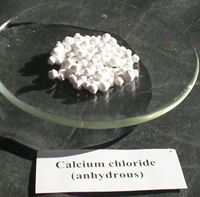Calcium chloride
2007 Schools Wikipedia Selection. Related subjects: Chemical compounds
| Calcium chloride | |
|---|---|
 |
|
| General | |
| Systematic name | calcium chloride |
| Other names | calcium(II) chloride, calcium dichloride |
| Molecular formula | CaCl2 |
| Molar mass | 110.99 g/mol, anhydrous 147.02 g/mol, dihydrate 182.04 g/mol, tetrahydrate 219.08 g/mol, hexahydrate |
| Appearance | white or colourless solid |
| CAS number | [10043-52-4], anhydrous [10035-04-8], dihydrate [25094-02-4], tetrahydrate [7774-34-7], hexahydrate |
| Properties | |
| Density and phase | 2.15 g/cm3, anhydrous 0.835 g/cm3, dihydrate 1.71 g/cm3, hexahydrate |
| Solubility in water | 74.5 g/100 ml (20 °C) |
| In ethanol In acetone In acetic acid |
soluble |
| Melting point | 772 °C (anhydrous) |
| Boiling point | >1600 °C |
| Vapour Pressure | 11 hPa |
| Structure | |
| Coordination geometry | octahedral, 6-coordinate |
| Crystal structure | deformed rutile |
| Hazards | |
| MSDS | External MSDS |
| EU classification | Irritant (Xi) |
| NFPA 704 | |
| R-phrases | R36 |
| S-phrases | S2, S22, S24 |
| RTECS number | EV9800000, anhydrous EV9810000, dihydrate EV9830000, hexahydrate |
| Supplementary data page | |
| Structure & properties | n, εr, etc. |
| Thermodynamic data | Phase behaviour Solid, liquid, gas |
| Spectral data | UV, IR, NMR, MS |
| Related compounds | |
| Other anions | calcium fluoride calcium bromide calcium iodide |
| Other cations | magnesium chloride strontium chloride |
| Except where noted otherwise, data are given for materials in their standard state (at 25°C, 100 kPa) Infobox disclaimer and references |
|
Calcium chloride is a chemical compound of calcium and chlorine. It is highly soluble in water and it is deliquescent. It is a salt that is solid at room temperature, and it behaves as a typical ionic halide. It has several common applications such as brine for refrigeration plants, ice and dust control on roads, and in cement. It can be produced directly from limestone, but large amounts are also produced as a by-product of the Solvay process. Because of its hygroscopic nature, it must be kept in tightly-sealed containers.
Chemical properties
Calcium chloride can serve as a source of calcium ions in solution, for instance for precipitation because many calcium compounds are insoluble:
3 CaCl2( aq) + 2 K3PO4( aq) → Ca3(PO4)2( s) + 6 KCl( aq)
Molten CaCl2 can be electrolysed to give calcium metal:
CaCl2( l) → Ca( s) + Cl2(g)
Preparation
Calcium chloride is a by-product of the Solvay process used for the manufacture of sodium carbonate. It can also be produced by the action of hydrochloric acid on calcium carbonate CaCO3( s) + 2 HCl → CaCl2(aq) + H2O( l) + CO2(g)
Uses
Millions of tonnes of calcium chloride are made each year in the US alone, and in 1990 the bulk price there was $182 per tonne. It has a variety of applications:
- Because it is strongly hygroscopic, air or other gases may be channeled through a column of calcium chloride to remove moisture. In particular, calcium chloride is usually used to pack drying tubes to exclude atmospheric moisture from a reaction set-up while allowing gases to escape. It can also be added to liquids to remove suspended or dissolved water. In this capacity, it is known as a drying agent or desiccant. It is converted to a brine as it absorbs the water or water vapor from the substance to be dried:
- CaCl2 + 2 H2O → CaCl2·2H2O
- The dissolving process is highly exothermic and rapidly produces temperatures of around 60° C (140° F). This can result in burns if humans or other animals eat dry calcium chloride pellets. Small children are more susceptible to burns than adults, and calcium chloride pellets should be kept out of their reach.
- Aided by the intense heat evolved during its dissolution, calcium chloride is also used as an ice-melting compound. Unlike the more-common sodium chloride (rock salt or halite), it is relatively harmless to plants and soil. It is also more effective at lower temperatures than sodium chloride. When distributed for this use, it usually takes the form of small white balls a few millimetres in diameter, called prills (see picture at top of page).
- It is used in concrete mixes to help speed up the initial setting. However chloride ion leads to corrosion of steel rebars, so it should not be used in reinforced concrete.
- It is used for dust control on some highways, as its hygroscopic nature keeps a liquid layer on the surface of the roadway, which holds dust down.
- Calcium chloride tastes extremely salty and is used an ingredient in some foods, especially pickles, to give a salty taste while not increasing the food's sodium content.
- It's also used as an ingredient in canned vegetables to maintain firmness.
- Used as an additive in plastics.
- Used as a drainage aid for wastewater treatment.
- Aqueous Calcium Chloride is used in genetic transformation of cells by increasing the cell membrane permeability. This allows DNA fragments to enter the cell more readily.
- Tire ballast
- Additive in fire extinguishers
- Additive to control scaffolding in blast furnaces
- It can be used to make ersatz caviar from vegetable or fruit juices.
- It is used in Smartwater and some sports drinks as an Electrolyte
Precautions
Calcium chloride is an irritant; wear gloves and goggles to protect hands and eyes; avoid inhalation.
Although calcium chloride is relatively safe to handle, care should be taken that it is not ingested. Calcium chloride reacts exothermically with water and can burn the mouth and esophagus.
